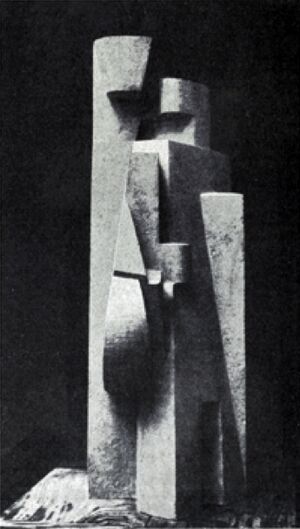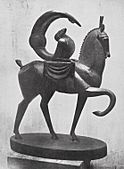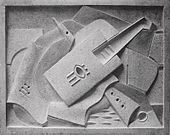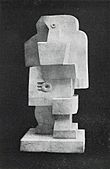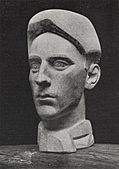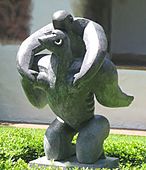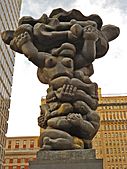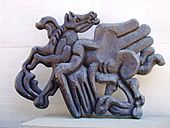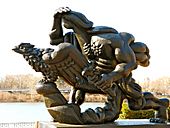Jacques Lipchitz facts for kids
Quick facts for kids
Jacques Lipchitz
|
|
|---|---|
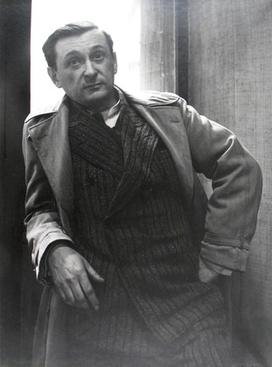
Jacques Lipchitz, 1935, photograph by Rogi André (Rozsa Klein)
|
|
| Born |
Chaim Jacob Lipschitz
22 August 1891 Druskininkai, Lithuania
|
| Died | 26 May 1973 (aged 81) |
| Nationality | French, American |
| Education | École des Beaux-Arts |
| Known for | sculpting |
| Movement | Cubism |
Jacques Lipchitz (born August 22, 1891 – died May 26, 1973) was a famous Cubist sculptor. Cubism is a style of art where artists break down objects into geometric shapes. In his early works, Lipchitz's sculptures looked like real things. But after 1915–1916, his art became more abstract, using a style called Crystal Cubism. In 1920, Lipchitz had his first solo art show in Paris. Later, he had to leave France because of the Nazis. He moved to the United States, settling in New York City and then in Hastings-on-Hudson.
Life and Career
Jacques Lipchitz was born Chaim Jacob Lipschitz in a Jewish family in Druskininkai, Lithuania. At that time, Lithuania was part of the Russian Empire. His father was a building contractor. Jacques studied at Vilnius grammar school and Vilnius Art School. From 1906 to 1909, he studied engineering because his father wanted him to. But with his mother's support, he moved to Paris in 1909. There, he studied art at famous schools like the École des Beaux-Arts and the Académie Julian.
In Paris, he lived in artistic neighborhoods like Montmartre and Montparnasse. He became friends with famous artists like Juan Gris and Pablo Picasso. His friend, Amedeo Modigliani, even painted a picture of Jacques and his wife, called Jacques and Berthe Lipchitz.
Living among these artists, Lipchitz soon began creating Cubist sculpture. In 1912, he showed his art at big exhibitions in Paris. His first solo show was in 1920 at Léonce Rosenberg's gallery. In 1922, the Barnes Foundation in Pennsylvania asked him to create seven bas-reliefs (sculptures that stick out from a flat surface) and two other sculptures.
In the 1920s, Lipchitz loved trying new things in his art. He experimented with abstract shapes, creating what he called transparent sculptures. Later, he developed a more energetic style. He used this style to make amazing bronze sculptures of people and animals.
In 1924–1925, Lipchitz became a French citizen and married Berthe Kitrosser. During World War II, when the Nazis took over France and were persecuting Jewish people, Lipchitz had to escape. With help from an American journalist named Varian Fry, he left France and went to the United States. He eventually made his home in Hastings-on-Hudson, New York.
In 1949, he was one of 250 sculptors who showed their work at a big international sculpture show in Philadelphia. In 1954, a special show of his artworks traveled from New York to Minneapolis and Cleveland. In 1959, his series of small bronze sculptures, To the Limit of the Possible, was shown in New York.
In his later years, Lipchitz became more connected to his Jewish faith. He even called himself a "religious Jew" in an interview. He started following Jewish traditions more closely, like not working on the Sabbath (Shabbat) and wearing special prayer items called Tefillin. He was encouraged to do this by a wise rabbi named Menachem Schneerson.
Starting in 1963, he spent several months each year in Europe, working in Pietrasanta, Italy. He became good friends with another sculptor, Fiore de Henriquez. In 1972, his life story, written with H. Harvard Arnason, was published. This happened at the same time as an exhibition of his sculptures at the Metropolitan Museum of Art in New York.
Death and Legacy
Jacques Lipchitz died in Capri, Italy. His body was flown to Jerusalem for burial, with a group including Rabbi Gershon Mendel Garelik.
His villa (a large house) in Tuscany, Italy, was given to Chabad-Lubavitch, a Jewish organization. Today, it hosts an annual Jewish summer camp.
Selected Works
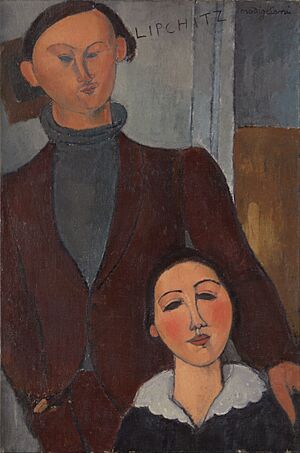
- Sailor with Guitar – 1917
- Drawing of a sculpture – 1916
- Bather – 1916–17
- Woman with Book – 1918, at Carleton College
- Bather, bronze – 1923–1925
- Dancer with Veil – 1928
- Dancer – 1929
- The Song of the Vowels – (Le Chant des Voyelles), – 1931 cast bronze sculptures at Cornell University; Princeton University; UCLA; Stanford University; Kykuit Estate Gardens (New York), Paris, and the Kröller-Müller Museum (Netherlands)
- Bull and Condor – 1932
- Bust of a Woman – 1932
- David and Goliath – 1933
- Embracing Figures – 1941
- Birth of the Muses 1944–1950, Massachusetts Institute of Technology (MIT) campus, Cambridge, Massachusetts
- Rescue II- 1947
- Mother and Child – 1949 at the Honolulu Museum of Art
- John F. Kennedy Memorial, London - 1965. This was originally on Marylebone Road but from 2019 has been in the lobby of the International Students House, London at 229 Great Portland Street
- Daniel Greysolon, Sieur du Lhut - 1965 at the University of Minnesota Duluth
- Bellerophon Taming Pegasus: Large Version – 1966–1977, begun in 1966 and arrived at Columbia Law School in pieces for assembly in 1977
- Peace on Earth – 1967–1969
- Government of the People – 1976
Gallery
-
Jacques Lipchitz, 1920, Portrait of Jean Cocteau
-
Mother and Child, 1930, Honolulu Museum of Art
-
Birth of the Muses, bronze, 1944–1950, In memory of Jerome Wiesner - in the permanent collection of the Massachusetts Institute of Technology
-
The Spirit of Enterprise, 1960, in Fairmount Park, Philadelphia
See also
 In Spanish: Jacques Lipchitz para niños
In Spanish: Jacques Lipchitz para niños
- Crystal Cubism


